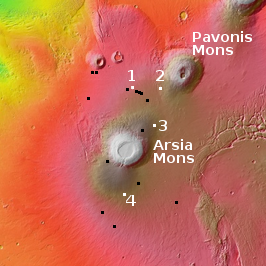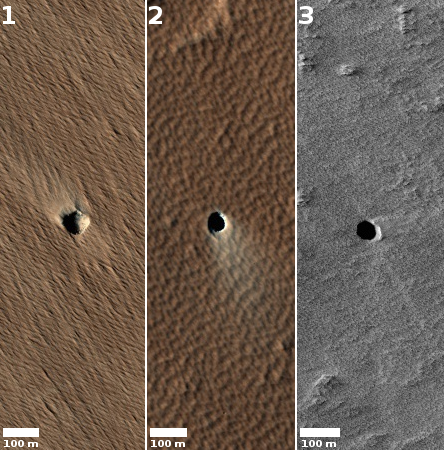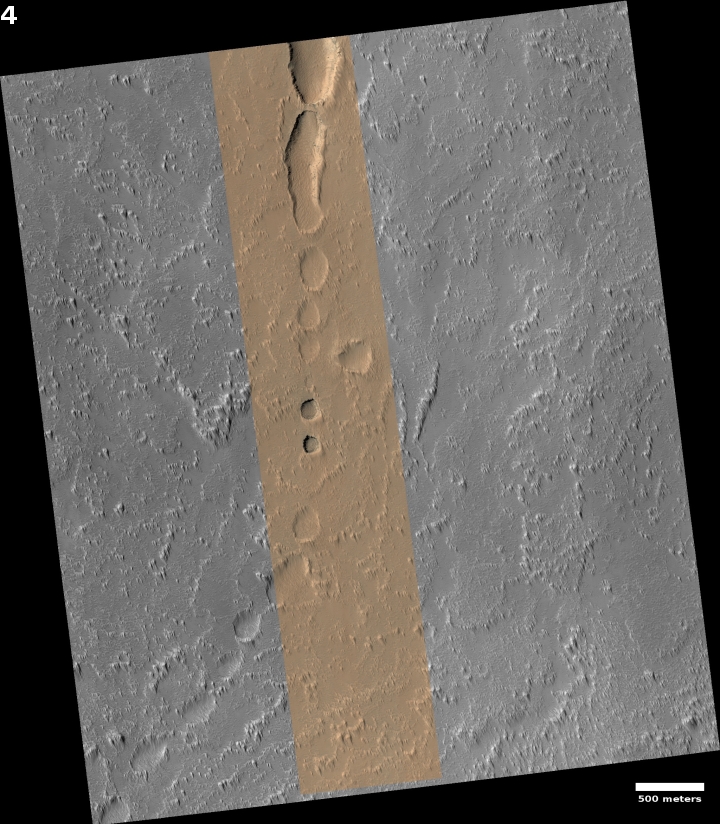Where are the caves on Mars?

Each month I go through the monthly download of new images from the high resolution camera on Mars Reconnaissance Orbiter (MRO). And each month since November I have found a bunch of newly discovered pits photographed in the region around the volcano Arsia Mons (see: November 12, 2018, January 30, 2019, February 22, 2019, April 2, 2019, and May 7, 2019). The map on the right has been updated to include all those previous pits, indicated by the black boxes, with the new pits from June shown by the numbered white boxes.
To the right are the first three pits in the June archive, with the link to each image site found here (#1), here (#2), and here (#3).

For full images: Number 1, Number 2, Number 3.
All three are what the scientists doing this research call Atypical Pit Craters:
These Atypical Pit Craters (APCs) generally have sharp and distinct rims, vertical or overhanging walls that extend down to their floors, surface diameters of ~50–350 m, and high depth to diameter (d/D) ratios that are usually greater than 0.3 (which is an upper range value for impacts and bowl-shaped pit craters) and can exceed values of 1.8. Observations by the Mars Odyssey Thermal Emission Imaging System (THEMIS) show that APC floor temperatures are warmer at night and fluctuate with much lower diurnal amplitudes than nearby surfaces or adjacent bowl-shaped pit craters.
The fourth pit, shown in the reduced and cropped image below, might actually be the most interesting of the June lot.

Click for full image.
Unlike the others, this image does not show an atypical pit crater, but a series of relatively shallow depressions, two of which are deeper and sharp-sided, suggesting the existence of an underground lava tube flowing southward along this line and down from Arsia Mons to the north.
Unfortunately, MRO has not yet taken any other high resolution images either to the immediate north or south of this photograph, so we do not yet know for sure how far this supposed underground lava tube might extend. A look at this location with the lower resolution but wider view provided by Mars Odyssey’s camera strongly suggests that this is part of a much longer lava tube system.
Before I posted this June update, I wanted to get a better understanding of this research, so I contacted the scientist who as been requesting these images, Chris Okubo of the U.S. Geological Survey. I wanted first of all to find out how he knew where to aim MRO to find these pits. He explained that he was working with Glen Cushing, also of the USGS, who had been the lead author of the scientific paper above and who has provided me considerable help for my previous posts. Okubo explained that,
Glen finds possible pits in lower resolution images, such as CTX [on MRO] and THEMIS [on Mars Odyssey] then passes the coordinates on to me…We are just cataloging them in the hopes that someday one of us, or someone else will have the time to investigate these further.
If you compare my map above with the map in Cushing’s 2015 paper, posted by me on June 9, 2015, you can see a close match between many of the high resolution pits that MRO has been photographing with the pits found by Cushing using the Mars Odyssey THEMIS camera.
It appears therefore that they are not so much discovering new pits but getting high resolution images of those previously identified pits. A quick scan of both maps suggests that they have so far captured only a small percentage, but my map is certainly not complete since I only started this monthly review about a year ago. I suspect if I was to go through the entire MRO archive since 2015 I would find many more high resolution pit images. Since they seem to image about three a month, that would mean that since 2015 they have probably photographed a majority of the 100 or so pits identified in the 2015 paper.
This concentration of pits/caves on Arsia Mons raised an additional question in my mind. In my review of the MRO archive I have found comparatively few caves or pits photographed in any other region on Mars. A few have been found, but my impression is that the bulk of caves/pits so far found on Mars have all been on the volcano slopes near Arsia Mons. I wondered if this pattern was due to some fundamental aspect of Martian geology, or was because of a bias in either our instruments or observations. Dr. Okubo explained that the answer could be both:
The apparent lack of other pits/caves elsewhere on Mars may have something to do with past igneous activity on the Tharsis volcanoes (pits/caves forming in/above lava tubes or dikes). This is also likely biased by the fact that it’s easier to see the pits/caves in the bland, dust covered slopes of the Tharsis volcanoes, compared with the rougher terrain elsewhere.
As Dr. Okubo suggests, the data indicates that lava tubes can and have formed in the lower Martian gravity. The lack of other caves/pits elsewhere could simply be because we can’t see their entrances, or it could be that other types of caves, created from other kinds of flows (water, ice, etc), simply don’t form on Mars.
At the moment this remains an open question, but an important one, as it will tell us whether we shall find Martian caves in other places on the planet. Caves are excellent places to build a colony, as they provide protection from radiation and the daily wild swings in surface temperature. If caves are generally only found in the volcanic regions of Mars, we might find that our initial underground colonies either will be far from other resources, or we will have to build them on the surface, a considerably more challenging engineering problem.
If however caves are generally only found in the Tharsis region, and we find water/ice in only a few of these volcanic caves, those caves could end up to be among the most valuable real estate on Mars.
On Christmas Eve 1968 three Americans became the first humans to visit another world. What they did to celebrate was unexpected and profound, and will be remembered throughout all human history. Genesis: the Story of Apollo 8, Robert Zimmerman's classic history of humanity's first journey to another world, tells that story, and it is now available as both an ebook and an audiobook, both with a foreword by Valerie Anders and a new introduction by Robert Zimmerman.
The print edition can be purchased at Amazon or from any other book seller. If you want an autographed copy the price is $60 for the hardback and $45 for the paperback, plus $8 shipping for each. Go here for purchasing details. The ebook is available everywhere for $5.99 (before discount) at amazon, or direct from my ebook publisher, ebookit. If you buy it from ebookit you don't support the big tech companies and the author gets a bigger cut much sooner.
The audiobook is also available at all these vendors, and is also free with a 30-day trial membership to Audible.
"Not simply about one mission, [Genesis] is also the history of America's quest for the moon... Zimmerman has done a masterful job of tying disparate events together into a solid account of one of America's greatest human triumphs."--San Antonio Express-News

Each month I go through the monthly download of new images from the high resolution camera on Mars Reconnaissance Orbiter (MRO). And each month since November I have found a bunch of newly discovered pits photographed in the region around the volcano Arsia Mons (see: November 12, 2018, January 30, 2019, February 22, 2019, April 2, 2019, and May 7, 2019). The map on the right has been updated to include all those previous pits, indicated by the black boxes, with the new pits from June shown by the numbered white boxes.
To the right are the first three pits in the June archive, with the link to each image site found here (#1), here (#2), and here (#3).

For full images: Number 1, Number 2, Number 3.
All three are what the scientists doing this research call Atypical Pit Craters:
These Atypical Pit Craters (APCs) generally have sharp and distinct rims, vertical or overhanging walls that extend down to their floors, surface diameters of ~50–350 m, and high depth to diameter (d/D) ratios that are usually greater than 0.3 (which is an upper range value for impacts and bowl-shaped pit craters) and can exceed values of 1.8. Observations by the Mars Odyssey Thermal Emission Imaging System (THEMIS) show that APC floor temperatures are warmer at night and fluctuate with much lower diurnal amplitudes than nearby surfaces or adjacent bowl-shaped pit craters.
The fourth pit, shown in the reduced and cropped image below, might actually be the most interesting of the June lot.

Click for full image.
Unlike the others, this image does not show an atypical pit crater, but a series of relatively shallow depressions, two of which are deeper and sharp-sided, suggesting the existence of an underground lava tube flowing southward along this line and down from Arsia Mons to the north.
Unfortunately, MRO has not yet taken any other high resolution images either to the immediate north or south of this photograph, so we do not yet know for sure how far this supposed underground lava tube might extend. A look at this location with the lower resolution but wider view provided by Mars Odyssey’s camera strongly suggests that this is part of a much longer lava tube system.
Before I posted this June update, I wanted to get a better understanding of this research, so I contacted the scientist who as been requesting these images, Chris Okubo of the U.S. Geological Survey. I wanted first of all to find out how he knew where to aim MRO to find these pits. He explained that he was working with Glen Cushing, also of the USGS, who had been the lead author of the scientific paper above and who has provided me considerable help for my previous posts. Okubo explained that,
Glen finds possible pits in lower resolution images, such as CTX [on MRO] and THEMIS [on Mars Odyssey] then passes the coordinates on to me…We are just cataloging them in the hopes that someday one of us, or someone else will have the time to investigate these further.
If you compare my map above with the map in Cushing’s 2015 paper, posted by me on June 9, 2015, you can see a close match between many of the high resolution pits that MRO has been photographing with the pits found by Cushing using the Mars Odyssey THEMIS camera.
It appears therefore that they are not so much discovering new pits but getting high resolution images of those previously identified pits. A quick scan of both maps suggests that they have so far captured only a small percentage, but my map is certainly not complete since I only started this monthly review about a year ago. I suspect if I was to go through the entire MRO archive since 2015 I would find many more high resolution pit images. Since they seem to image about three a month, that would mean that since 2015 they have probably photographed a majority of the 100 or so pits identified in the 2015 paper.
This concentration of pits/caves on Arsia Mons raised an additional question in my mind. In my review of the MRO archive I have found comparatively few caves or pits photographed in any other region on Mars. A few have been found, but my impression is that the bulk of caves/pits so far found on Mars have all been on the volcano slopes near Arsia Mons. I wondered if this pattern was due to some fundamental aspect of Martian geology, or was because of a bias in either our instruments or observations. Dr. Okubo explained that the answer could be both:
The apparent lack of other pits/caves elsewhere on Mars may have something to do with past igneous activity on the Tharsis volcanoes (pits/caves forming in/above lava tubes or dikes). This is also likely biased by the fact that it’s easier to see the pits/caves in the bland, dust covered slopes of the Tharsis volcanoes, compared with the rougher terrain elsewhere.
As Dr. Okubo suggests, the data indicates that lava tubes can and have formed in the lower Martian gravity. The lack of other caves/pits elsewhere could simply be because we can’t see their entrances, or it could be that other types of caves, created from other kinds of flows (water, ice, etc), simply don’t form on Mars.
At the moment this remains an open question, but an important one, as it will tell us whether we shall find Martian caves in other places on the planet. Caves are excellent places to build a colony, as they provide protection from radiation and the daily wild swings in surface temperature. If caves are generally only found in the volcanic regions of Mars, we might find that our initial underground colonies either will be far from other resources, or we will have to build them on the surface, a considerably more challenging engineering problem.
If however caves are generally only found in the Tharsis region, and we find water/ice in only a few of these volcanic caves, those caves could end up to be among the most valuable real estate on Mars.
On Christmas Eve 1968 three Americans became the first humans to visit another world. What they did to celebrate was unexpected and profound, and will be remembered throughout all human history. Genesis: the Story of Apollo 8, Robert Zimmerman's classic history of humanity's first journey to another world, tells that story, and it is now available as both an ebook and an audiobook, both with a foreword by Valerie Anders and a new introduction by Robert Zimmerman.
The print edition can be purchased at Amazon or from any other book seller. If you want an autographed copy the price is $60 for the hardback and $45 for the paperback, plus $8 shipping for each. Go here for purchasing details. The ebook is available everywhere for $5.99 (before discount) at amazon, or direct from my ebook publisher, ebookit. If you buy it from ebookit you don't support the big tech companies and the author gets a bigger cut much sooner.
The audiobook is also available at all these vendors, and is also free with a 30-day trial membership to Audible.
"Not simply about one mission, [Genesis] is also the history of America's quest for the moon... Zimmerman has done a masterful job of tying disparate events together into a solid account of one of America's greatest human triumphs."--San Antonio Express-News


Talk of martian pits, lava tubes, and caves reminds me of this-
In Robert L. Forward’s 1991 SF novel ‘Martian Rainbow’ there is much discussion about the quickest, cheapest ( and dirtiest ) way to terraform Mars. The general consensus is that an atmospheric pressure between 1/3 to 1/2 of Earth’s was necessary ( the pressure at the top of Mt Everest is 1/3, or 350 millibars, that of sea level). One character even suggests digging a deep hole…” We just go to the middle of Hellas Basin and dig a hole forty kilometers ( 24 miles ) deep. The Martian atmosphere rushes in, and bingo, down in the bottom of the hole we have half an atmosphere.”
what about the so called grander canyon isn’t it several miles deep .why not drop a cave finder probe with a flying drone on it to enter any caves found around mons all of them , explore them all before we send human beings ,,,surely we can make a five year low orbiting cave finder something solar so it nevers dies continues to orbit for years and years and on these satelites we put rovers with drones also with a drone that can fly out of the caves to get sun power then back into the cave to recharge the rover maybe give the rover a rechargeable booster rocket incase it falls into a bollomless pit,,,this should be possible in this low gravity,,, maybe watching on get stuck deep will enspire a human trip to Mars…But even better a large cave system with hot springs and cold water falls large enough for 200 personal and crops maybe send seeds that the rovers can plant if a deep atmosphereic situation appears ..
We send one rover into the canyon and one into the mons area caves or two in each we put into orbit five satilites each with two combination cave exploring rovers each rover has two drones both recharge the rover and fly for twenty minutes each with cameras and rover recuing aids ,incase a rover finds a bottomless pit maybe put a hydrogen rechargeable booster rocket on the bottom thats ejectable and can be replaced in case of emergence.also on the orbiting satilites we put several replacement drones incase those that go into caves that have weird walls and ceiling as we know our caves are crazy get damaged